Thurn und Taxis
ThurnUndTaxis (Originalregel)
Game preparation
With /join 2-4 players can enter the game. With /start the game begins. Alternatively, you can use the game management use.
The game
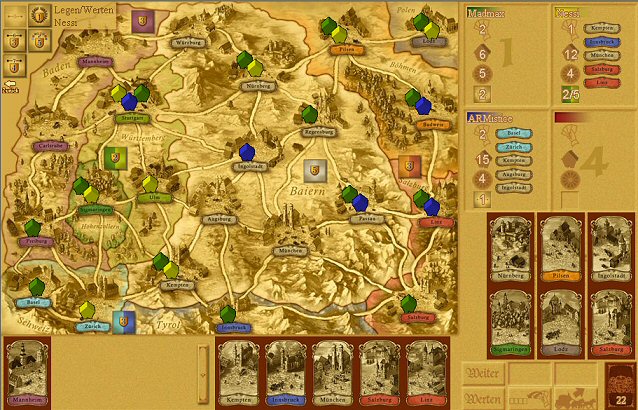
The task of the players is to build an effective postal carriage operation. Each player tries to place as many of his 20 track posts as possible through skillful route construction in the 22 cities. Players fight for the most valuable bonus platelets that can be reached for fully occupied areas and long route tours. In addition, everyone tries to get bigger coaches for their post operation during the game.
Field
The schedule shows the south German space with the adjacent countries. There are a total of 22 cities connected by roads. Below you will find your own hand maps on the left side, right next to the displaceable parting bar the played route maps.

At the top of the left, the bonus platelets are displayed, at the right side the status display appears, which player is just with which action at the turn.
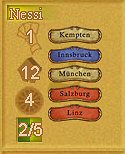
Right next to the plan you can see the player ad for all players. It shows from top to bottom:
- Number of handcards
- Number of items not yet designed
- Size of the carriage (shown in detail by tooltip)
- Number of bonus platelets, as well as the type of bonus platelet purchased last. In the case of your own ad, this is divided in two and shows the number/point value of your own bonus platelets. If you have a mouse over your own bonus, you will get a detailed display of your own bonus platelets on the left of the card.
In addition, the currently designed route is shown.
Below the player's display are the six open maps of the card edition, including the ad for the officials and on the right of it the hidden draw-off pile.
Game sequence
Each draw consists of 2-3 actions:
- man must: draw a map
- man must: a map
- man can value the outlying distance if it has at least a length of 3
- man can carry out another action by supporting an official
Officials
Per train exactly one using the four official persons to his advantage. You have the following properties:

Amtmann - exchanges the issue of the six open cards
The official can only be elected if you have at least one card on the hand. If you don't like one of the cards you're looking for, you can replace the entire card edition with the help of the officer instead of pulling a hidden one. To do this, simply click the Amtmann button.

Postmaster - allows drawing a second card
You can pull two instead of just one city map at the beginning. The postmaster does not have to be explicitly selected; you just pull a second card after the first one. Do not have a card on hand at the beginning of a round, must: the postmaster will be elected (so also at the start of the game!).

Postillion - allows playing a second card
With the Postillion you can create a second map to its route. The same conditions apply as for the first card. Postillion does not have to be activated extra; you just click on a second card to get out.

Wagner - extends the route by two virtual cards when purchasing a carriage
The Wagner helps one to a larger carriage than one would achieve it through its played route. If, for example, one has a route of length 4 and already a five-cartridge, then one can obtain a six-cartridge by the Wagner (see "Value"). The virtual extension applies only to the carriage card and counts not for the bonus platelets "stretch length". If you want to use the Wagner, you have to select the Wagner button.
draw map(s)
At the beginning of the round must: the active player draw a city map. It may choose from one of the six open cards of the lining or draws a card from the covered stack. The lining is immediately refilled.
Map(s)
The active player must: a map. If he doesn't have any cards, he's allowed to play any. If he has already left a route, the map now designed must connect to this route; i.e. the city must be one of two outer Cities of the outlying route have a direct road connection. Thus, no branchings may be formed or the route may be split. In addition, the city must not be represented in the route.
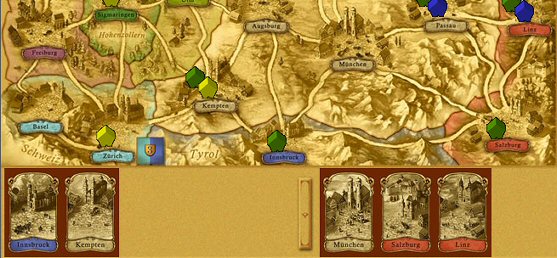
The Munich - Salzburg - Linz route has been designed to the right. The player still has Innsbruck and Kempten on his hand. Kempten must not be played (same) because it has neither a direct road connection to Linz nor Munich. Innsbruck may be played because it has a direct connection to Munich.
If the player selects the Innsbruck card, the possible selection window will appear on the right of the outlying route; in this case only one appears because Innsbruck can only be created to Munich, but not to Linz. By clicking, the card is created there. Now Kempten (with the help of the Postillion) is also likely to be designed, as this could now be applied to Innsbruck.
If the unfavorable case occurs that a player cannot connect his handcards to the outlying route, he must tear them off and start a new one.

Here in the picture is the route Carlsruhe - Mannheim - Würzburg, to which neither Linz nor Salzburg can be applied in a regular manner. The player now has to take off his route with a serious heart (click on the right button) which is of course not evaluated and then has to start a new one with Linz or Salzburg.
Value route
If you have reached a route length of at least 3, you can now value this route. If you don't want to, you finish your train by clicking on the Next button.
If you decide on the value, you can now use the cities of your route. There are two possibilities:
- you put in a city per country, which is involved in the route,
or
- you put in a country in any city a route post.
All designated cities are marked with a route post in brighter player color. Now you choose the cities fromThe not would like to or cannot be valued; they are presented as gray houses. If you are satisfied with the selection, you can confirm with the finished button. If this does not appear, you did not select the route items in accordance with the rules.
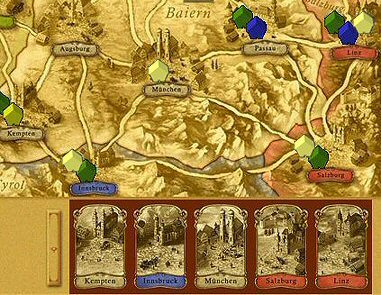
The yellow player has designed a route of five cities and now wants to value them. Kempten falls directly from the score, because there is already a yellow route post. Innsbruck - Munich - Salzburg - Linz are available as candidates. The player now has two options:
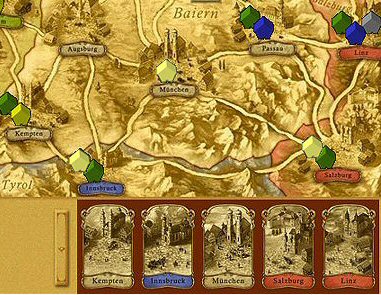
He chooses the option mentioned above and sets per country in a city a route post; to Innsbruck (Tyrol), Munich (Baiern) and Salzburg (Salzburg). Linz is also located in Salzburg and can therefore no longer be chosen.
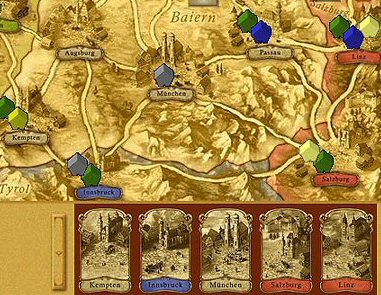
Or he chooses the second option and evaluates all cities of a country. Here he takes the two cities in Salzburg (Salzburg and Linz). This means that he cannot choose Innsbruck or Munich. Alternatively, he would also have Innsbruck or Munich, however, could only have got rid of one route post.
Subsequently, new coaching cards and/or bonus platelets may be awarded and handed over hand cards:
Carrots
Each player can purchase a maximum of five better carriages. carriages are always only awarded directly ascending; i.e. one acquires first a threesome-cut, then a four, five, etc. No step may be skipped, even if this would be possible from the route length. The next higher carriage is always obtained if the route length corresponds at least to the required number of carriages.
So if a player has a four-cartridge so far, he must now value a route of at least the length 5 for obtaining a five-cartridge. He can also use the Wagner (see above).
There are carriages of sizes 3/4/5/6/7.
Bonus platelets
If you meet certain requirements after a review, you can upgrade your point account with bonus platelets. For all bonus plates:
- they are only available in limited quantities. Here the following applies: Who comes first, grinds first
- they are so sorted that the highest are above and the smallest are below
There are four types of bonus platelets:
Fully occupied countries





These bonus platelets are obtained when you enter any city the corresponding colored country or the two country combinations has a route post. The country platelets are located in the corresponding countries or at the country border.
Distance



If the valued distance comprises at least 5,6,7 or more cards, the top card of the corresponding stack is obtained. If the exact length is no longer present, the top card of the stack is obtained for the next short distance. This also applies to routes longer than 7. A player can purchase several bonus plates of the same length during the game.
All countries

You get this bonus platelet when you get in All Member States a It has been in progress. It doesn't matter how many cities are occupied in each country - the main thing in one of them is a route post.
Playing

The player who first reaches one of the end conditions will receive this bonus plate.
City maps
If you have more than three cards on hand after a score, you have to discard the overcounting.
Playing
The game ends as soon as a player has either installed all his route posts or has purchased the seven-cartridge. He gets the bonus plated player that counts a win point. The current round is still played at the end.
Value
When playing, the total score is calculated from the following points:
- Points highest Carriage card: carriages of size 3/4/5/6/7 count 2/3/5/7/10
- Points of all received bonus platelets
- less the number of items not used
In case of balance, players with most win points win the one who owns the bonus platelet player or sits closest to the owner in game order.
Options
map 1 South/2 North
With this option you can switch between the maps of southern and northern Germany. For the South German map excl. the rules of the original game, while the Northern Germany card can be played with the standard rules (including the new rules for using houses and for the bonus platelets) as well as with the option "horses" (see below).
The following special features apply to the North German map:
- to get the bonus platelet for Prussia, you have to All seven cities in both parts of Preussen building a house
- the free capitals of Frankfurt, Hamburg, Bremen and Lübeck do not belong to any country. Maximum per value a It is not possible to make a mistake. The player who is a rich city First evaluates, receives the bonus platelet.
- In order to get the bonus platelet "All countries", you must be represented at least once in each country. Rich cities don't count.
Horses
The "horses" option can only be played with the North German map. The rules of the basic game apply up to the following exceptions:
- the official "Wagner" and the tickets from the basic game are not required
- each player receives a carriage card with two horses
The city maps now have two functions: they can be played as usual city maps, or you turn them around and put the back with the horses on his carriage. To do this, you select the desired hand card and then click on its carriage. If you choose the Postillion, you can also combine the two actions: so create a city map on the route, create a city map on the carriage.
If you want to evaluate a track, the carriage must have at least as many horses (horts) as the track is long. It should be noted that the carriage is already pulled by two horses. A maximum of six cards may be placed on the carriage.
After the evaluation, all designed city and horse cards are delivered. Here, too, the rule applies that only a maximum of three cards can be kept on hand after the score.
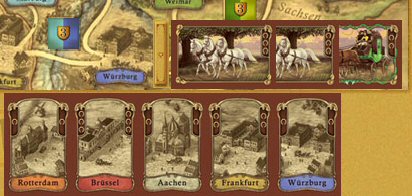
Here the player has already set up a five-track. He has already created two cards with three horses (horts) on his carriage, so that with this equipment (3+3+2 horses), he can even value an eighth track.
Once a player has installed all his houses, the round will be played to the end. Then the game ends.

